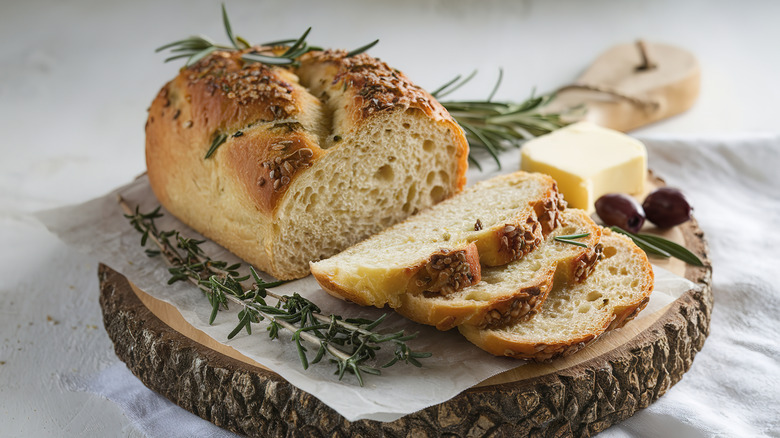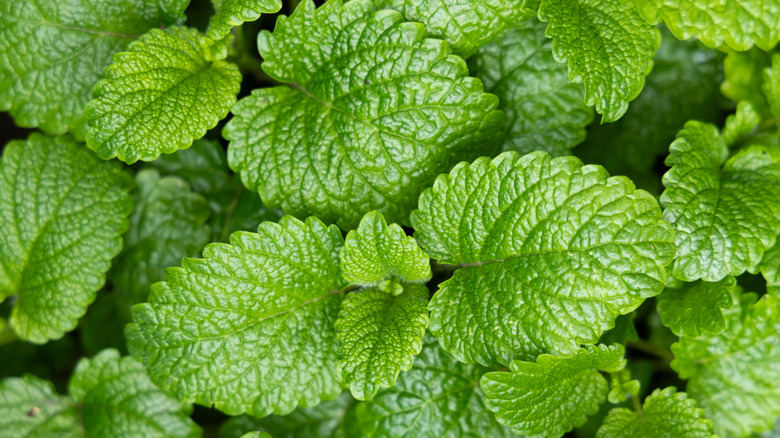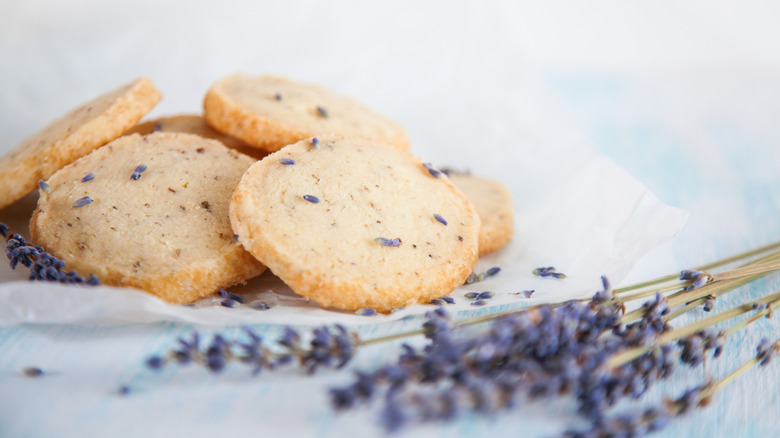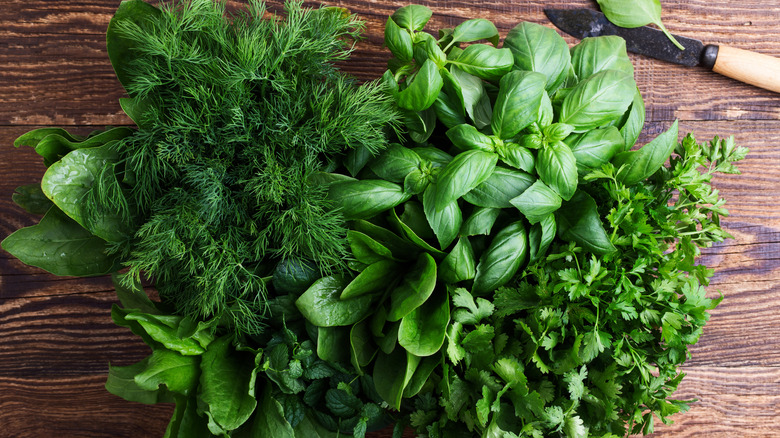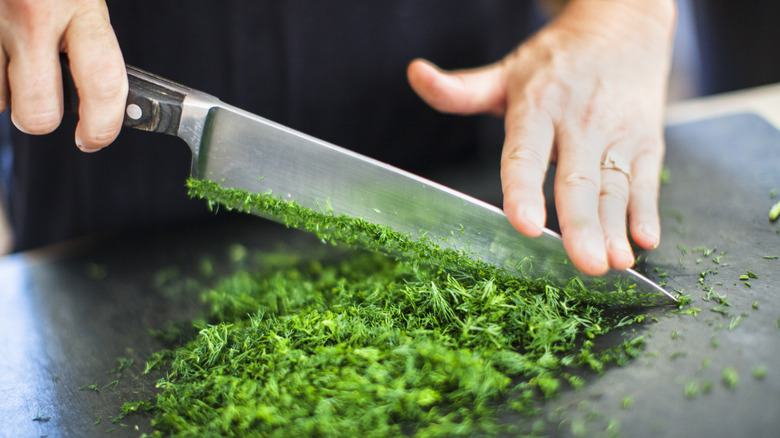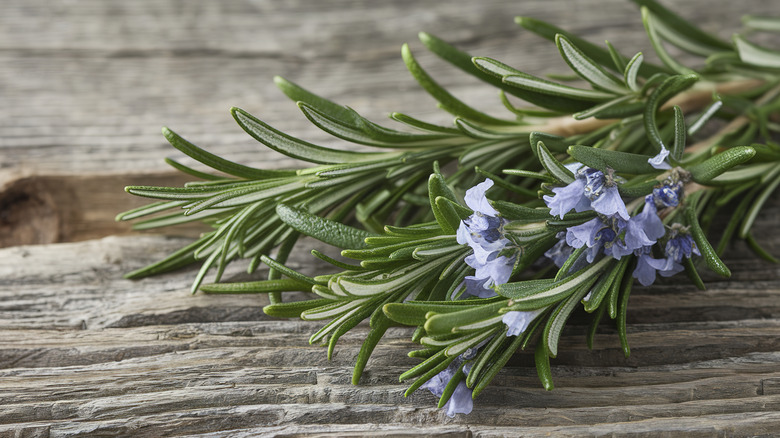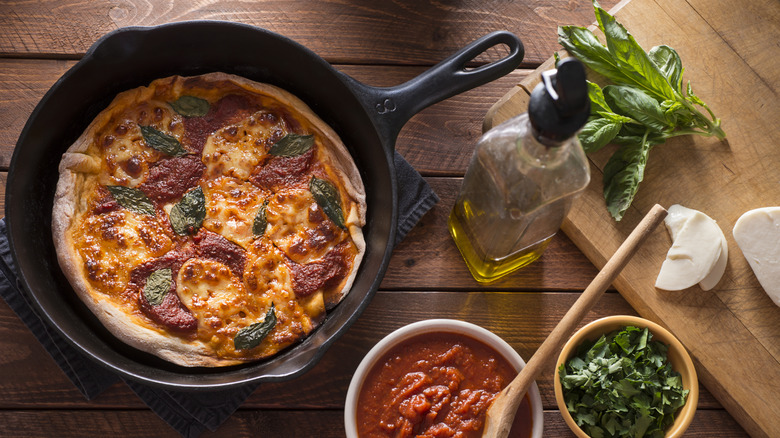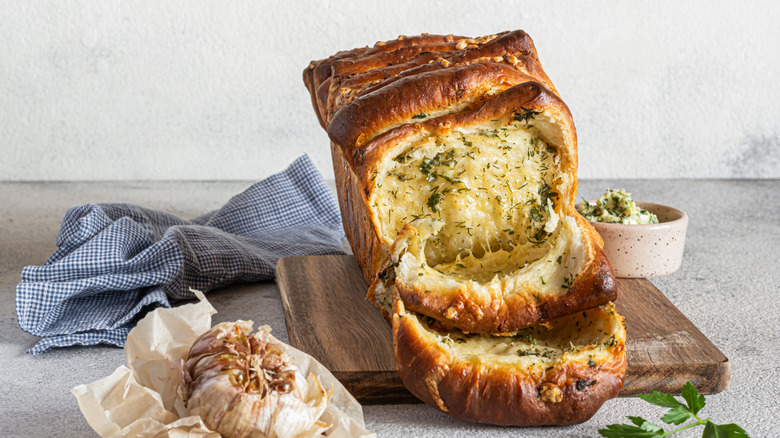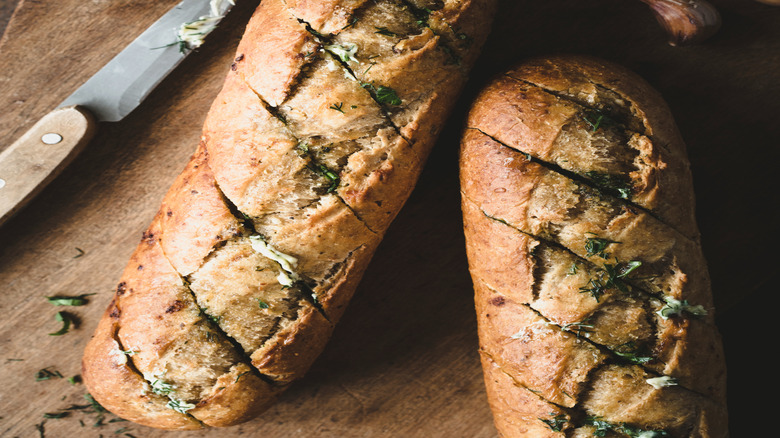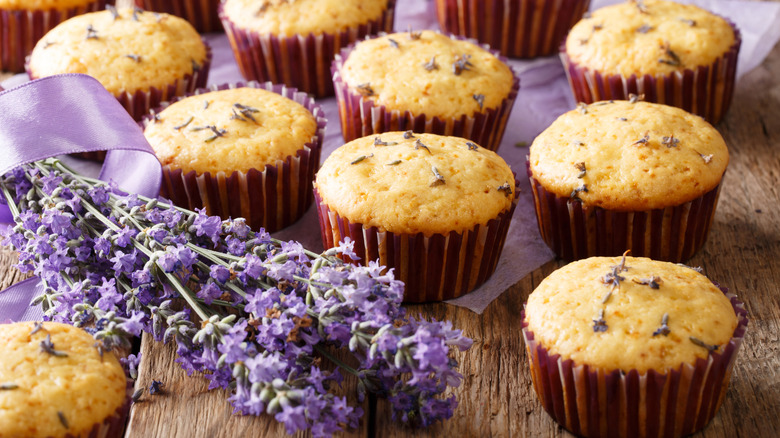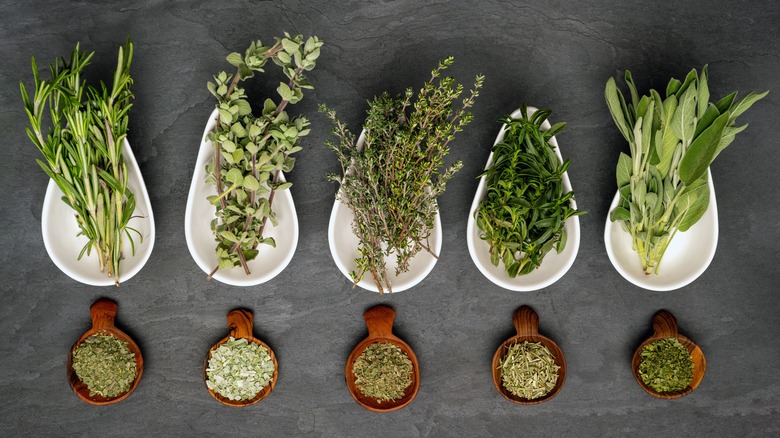How To Bake With Fresh Herbs Like A Pro
We may receive a commission on purchases made from links.
Herbs are an amazing way to layer in flavor when you're baking. They work well in a base or as a finish, and freshness makes them even more appealing. Not only does it give you a zing that dried herbs don't, but they're beautiful to boot. The only thing is, you have to know how to use them since you can't simply sub them in for the regular seasonings on your rack.
There are a few aspects of fresh herbs that can prove tricky for the home cook. First off, they're expensive. If you don't grow them in your garden, you may end up paying quite a lot for them — the average clamshell of basil or sage is about $3. Add in the fact that it's easy to bruise or misuse fresh herbs, plus the fact that they go bad quickly in the fridge if not properly stored, and you have a perfect storm of wasted kitchen funds.
The good news is, it doesn't have to be that way. Whether you're looking to incorporate fresh thyme, delicious dill, brilliant green basil, or any other herb into your cuisine routine, all you need is a little knowledge drop. That's why Chowhound recently caught up with a couple of chefs to get their take on all things herby. As Alex Mazzucca and Cara Duerr, co-owners of the plant-based restaurant and brand Seed to Sprout, say, "Don't be afraid to play around and have fun by incorporating fresh herbs into your favorite dishes, from sweet to savory!"
Identifying and sourcing fresh herbs
Fresh herbs are green (or, depending on their variety, green-gray), usually still on the stem, and undried. They're different from dried herbs in several ways. "Fresh herbs should look vibrant and crisp, with no yellowing, browning, or wilting," says Julia Chebotar, blogger at Health Chef Julia and Food Network's "Chopped" Champion. "The scent is also a giveaway — rub a leaf gently between your fingers, and it should release a bright, unmistakable aroma." Once you've smelled the difference between ho-hum old herbs and the just-harvested variety, you never need to be convinced again.
"For sourcing, I recommend visiting your local farmers market for the freshest, most flavorful options," Chebotar says, adding that wherever possible, you should avoid herbs in plastic clamshells. Also, says cookbook author Jessie-Sierra Ross of Straight to the Hips, Baby, "Many common herbs are easy to grow yourself, indoors or out: basil, thyme, dill, parsley, chives, and cilantro thrive when potted up and placed in a sunny spot on your counter."
Since fresh herbs can be pretty expensive if you don't grow them yourself, why not give it a try? If you have limited indoor space, you can always try an herb garden starter kit. Typically, these come with the seed packets, pots, and accessories needed to grow a windowsill container garden. If you do have some outside space to play with, then all you need are some high-quality seeds to grow excellent herbs. Either way, Ross adds, "Always remember to buy your herbs from a trusted source that doesn't use harmful growing practices like harsh chemical pesticides or industrial fertilizers."
What kinds of baked dishes call for fresh herbs?
So, you want to bake with fresh herbs. Most home cooks are pretty familiar with cooking with herbs, at least the dried variety, but often the fresh as well. Baking, on the other hand, is a different matter, but the truth is that a range of baked goods benefit from fresh herbs. Think pizzas, breads, cakes, muffins, biscuits, and cornbread. You may also add them to meat filling for some types of baked goods, in which case you might cook them as a base before baking (e.g., sausage stuffing or duxelles).
There's an endless number of approaches, and the chefs agree. "Fresh basil is gorgeous sprinkled on top of a crispy pizza, but it's also delicious when worked into a pastry, like a strawberry-basil scone," Jessie-Sierra Ross says. "You can also make a gorgeous galette (a sort of rustic pie) using a round of butter pastry dough, filled with fresh thyme, savory goat cheese, and ripe tomato slices." She adds that some herbs work well with specific flavors: rosemary and citrus, for instance — especially lemon.
Alex Mazzucca and Cara Duerr throw a few more ideas on top of that: fig scones, chive biscuits, and lavender blueberry layer cake. As for Julia Chebotar, "Fresh herbs bring a delightful twist to savory baked goods like focaccia, biscuits, or savory muffins." In order to elevate your dish, though, you have to make sure the chosen herb is complementary to the existing flavors. This will give you "a balanced, aromatic result," she says.
Wash herbs immediately and store them properly
Many folks bring herbs home and immediately throw them in a crisper, either with or without a bag to protect them. (Guilty.) However, this isn't the best way to keep them nice. Instead, you'll want to clean, dry, and store them properly when you bring them home. "Wash herbs gently under cool running water, then dry thoroughly with a kitchen towel or salad spinner," Julia Chebotar instructs. Then they're ready for storage, a process which varies depending on the herb in question. This is important, Jessie-Sierra Ross says, to avoid contaminants: "Just like other types of fresh produce, trace amounts of dirt, organic pesticides, or even E. coli can find its way to your cutting board if you don't take the needed precautions."
"Although all fresh herbs can be stored in the refrigerator, some retain their flavors (aromatic oils) best when stored at room temperature," explains Ross. "Woody herbs like rosemary, thyme, and oregano do well mixed into a damp paper towel in the refrigerator. Basil can be stored in the same way, but it will be even more flavorful if you treat it like a bouquet of flowers." To do this, wash and dry, then snip the ends off the stems. Next, place them in a mason jar or other small container filled with a bit of water, then store them on the counter. If you keep them out of direct sunlight, they can last up to 10 days.
Basil isn't the only herb for which this works, say Alex Mazzucca and Cara Duerr. Cilantro and parsley are also good options for the bouquet treatment.
Prep herbs correctly
Herbs need to be prepped in different ways depending on their type, use, and when they'll be added to baked goods. Often you want to chop them finely to release the maximum amount of flavor, but that's not always the case. "Chop woodier herbs finely for even distribution," says Julia Chebotar. Prime candidates include thyme, rosemary, oregano, and sage. However, she adds, "softer herbs can often be torn or used whole." Think basil, mint, cilantro, parsley, and dill, all of which are chewable and delicious, so they don't need mincing.
It's important to take the right approach, especially if you're using herbs as a garnish. If you cut tender green herbs such as basil and mint with a steel blade, Jessie-Sierra Ross explains, you will bruise them. This in turn causes dark discoloration, which takes away from the pretty fresh effect of the leaves on your fruit salad, cake, or bread. If you're not using them whole, always gently tear them to the desired size by hand.
If you have extra herbs you're not going to freeze right away, then you can preserve them by using the ice cube trick. That way, you'll always have them on hand for the next time you step into the kitchen. Freezing destroys the structural integrity of plant cells, so this won't work for herbs you want to use as garnishes, but it is a great way to keep them safe for later baked dishes.
Choose the correct herbs for extensive cooking
Many people are confused about when to add fresh herbs during cooking. The whole point of fresh herbs is freshness, so broiling the heck out of them might seem counterintuitive ... because often, it is. "When cooking with herbs, your most heat tolerant will be the heartier herbs like rosemary, thyme, or oregano," say Alex Mazzucca and Cara Duerr. "We recommend using more delicate herbs like basil or cilantro for garnishing your dishes once cooked."
Jessie-Sierra Ross agrees: "Tender-structured (think thin-leaf) green herbs like basil, mint, and cilantro can burn easily with direct heat, and should be worked into a dough, or added to filling, to be protected from any high baking temperatures." Thicker-leaved herbs hold up well not only during long baking times or when exposed to high heat — like you'd find on top of a focaccia bread or pizza — but can also take the rigors of a braise or roast without issue. If you want that mint or basil flavor, all you have to do is add it towards the end, such as in the last minute of cooking a pizza or as a garnish once the dish is finished.
This is important if you don't want to waste your herbs. Some of the more delicate herbs lose their flavor when exposed to heat. That's because volatile oils, the ones responsible for the flavor of herbs, get cooked off, i.e., destroyed by the baking process. Once they're gone, so is the flavor of that herb, rendering its use pointless. Sure, they may still add a bit of color, but even that is usually gone after extensive baking. Thus, it's very important to incorporate tender herbs in a protected manner: inside dough or filling.
Watch for burning
Unfortunately, evaporation of flavorful oils isn't the only concern to watch for when baking. Because fresh herbs are so delicate, they burn quickly. This is especially true of the thin-leaved varieties, such as basil, mint, dill, cilantro, and parsley. Their oil content also makes them more heat-retentive, which increases the danger further. This not only makes their use pointless, but it can be downright detrimental to your dish. Julia Chebotar says: "Herbs burn easily because their delicate oils and leaves are sensitive to prolonged exposure to heat, leading to a bitter taste."
Even worse, the smell of burnt herbs can linger for a long time, which is nobody's idea of fun. Thus, if you're going to use the fresh kind without putting them in a protective dough or filling, you'll need to keep your eye on them. This may take some experimentation when you are first learning to bake with fresh herbs, but you'll get used to taking the right steps. For instance, once you add basil to the top of a pizza or focaccia, it's helpful to turn the oven light on and just watch what's happening in the oven. That way, you can pull them out before the herbs burn.
Add herbs to batters and dough at the right time
"Timing and use are very important when using fresh herbs in baking," Jessie-Sierra Ross says. "If you are looking for a pop of flavor, it's best to use delicate green herbs like cilantro, basil, parsley, and dill when worked into a filling, batter, or dough to evenly diffuse their flavor and protect the herbs from burning." Add delicate herbs as soon as your dough or batter is mixed to avoid bruising them, and reserve them for baked goods that don't go into the oven as long, such as pizza or muffins.
"Woodier types like rosemary, thyme, and oregano can stand being cooked for longer periods of time and temperatures without losing their essence," she says. This makes them well-suited to heartier goods: sourdough, focaccia, shortbread, or biscuits. Take care to add herbs gently, she continues, either folding them in with a rubber spatula or using your hands. Woody herbs should be chopped finely and added in with the dry ingredients, say Alex Mazzucca and Cara Duerr: "This will help make sure they are evenly distributed in your final product."
Note that you have other options beyond adding the herbs themselves. "To amplify the flavor, you can first rub the herbs with a pinch of sugar or salt before incorporating them," says Julia Chebotar. Simply place the herbs in with the granules and rub them together. "The herb oils will infuse the sugar," Ross explains. "Then you can discard the stems or greenery."
Use fresh herbs as a garnish
Perhaps the place where fresh herbs shine the most is as a garnish, where their bright color and fresh scent can add that final, inimitable twist to your humble (or, in the case of dramatic inventions such as Alex Mazzucca and Cara Duerr's lavender blueberry layer cake, not-so-humble) creation. "When using herbs as a garnish for your dishes, you can simply chop them finely and sprinkle over your dish, or have fun and mix them into herb-infused oils or aiolis," advise the chefs.
"As a garnish, fresh herbs should be vibrant and intact," Julia Chebotar says. "Use a sprig of rosemary for a rustic touch, torn basil leaves for a fragrant finish, or edible flowers like chive blossoms for a pop of color." Your goal is to complement the dish both visually and aromatically, so choose appropriately.
For her part, Jessie-Sierra Ross loves hand-torn basil, parsley, and chives as garnishes for pizza or savory tomato tart. "You can also whip up a quick chimichurri sauce, which uses fresh parsley, cilantro, and oregano as a dipper for your next loaf of crusty bread," she says, whereas sugared rosemary goes well on sweet treats. To make it, "Wash and dry several fresh rosemary sprigs, and coat them in a sugar simple syrup, a 1:1 ratio of sugar and water brought to a rolling boil for 5 minutes." Pull out the rosemary stems and, while they're still wet, drag them gently through a plate filled with sugar. "These springs take on a beautiful sparkling crystal look after drying!"
Don't confine yourself to savory foods
Herbs are lovely in lots of sweeter baked goods. Lavender shortbread, thyme cake, and minty fruit crumbles are all good examples. The pungent taste often helps cut the sweetness that fruit and sugar add, bringing a layer of complexity to muffins, cookies, cakes, and sweet breads, similar to the way that savory additions such as nuts might. But as with other strong flavors typically associated with baking, you have to be careful not to go too far. Make sure when you are first learning to cook with fresh herbs that you look up recipes online to get the ratios right because those volatile oils can get overpowering real quick.
As with savory foods, make sure that when you are baking sweets that you are mindful of the flavor balance. Lavender and basil both combine extremely well with sugar and other flavors typically associated with patisserie and boulangerie, but you can't simply substitute one for another. Just like when making a soup or stew, make sure that if you're going to substitute herbs for one another — say, when substituting for basil — you choose plants or blends with a similar flavor profile.
Remember that herb leaves aren't the only way to get that flavor into your baked goods, says Julia Chebotar: "Don't shy away from experimenting with herb-infused oils or syrups to enhance your baked goods subtly. Also, consider using herb flowers like thyme blossoms or dill flowers — they add a delicate, unexpected burst of flavor and beauty."
Substitute fresh herbs for dried correctly
"It can be tricky getting the right measurements when swapping out dried herbs for their fresh counterparts," Jessie-Sierra Ross says. "Fresh green herbs are bulkier compared to their dehydrated versions, because they still have all of their structure," not to mention their water content.
If you are going to substitute fresh herbs into a recipe to enhance the flavor, make sure you do so in the right ratios. It takes a lot more fresh herbs than dried to get the same zing. Luckily, there's a trick: "As a general rule, use three times the amount of fresh herbs compared to dried," Julia Chebotar explains. "For instance, if a recipe calls for 1 teaspoon of dried thyme, use 1 tablespoon of fresh." Another easy way to think about this, Ross says, is that 1 teaspoon of dried herbs equals 1 tablespoon fresh. And remember, Chebotar cautions, because fresh herbs have more delicate flavors, you should add them later in the cooking process.
If you're going to use dried herbs instead of fresh, remember to store them in jars with tight-fitting lids. You should also keep them away from heat and light, as well as moisture. This will avoid the tendency of herbs to lose their volatile oils, and therefore their flavor, over time. Thus, they will last longer–typically between one to three years if properly cared for. Although spice racks are popular and this writer uses one herself, you can extend the shelf life of herbs by keeping them somewhere dark, such as a drawer, pantry, or cabinet.
